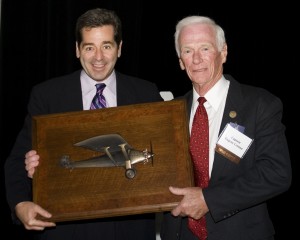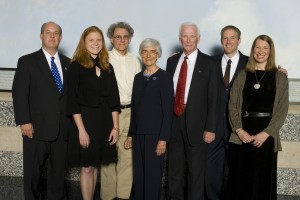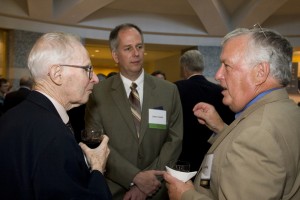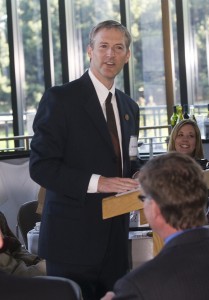
St. Louis sculptor Don F. Wiegand created the Spirit Award, a bronze bas-relief of the Spirit of St. Louis, presented to Gene Cernan (right). Miles O’Brien (left) served as master of ceremonies.
“Perspectives on the Earth – From Home, Above and Beyond” was the theme for the Lindbergh Foundation’s 30th annual Lindbergh Award Celebration on May 16, at the Minnesota History Center in St. Paul. The foundation presented four awards this year. National Geographic Society Conservation Fellow and Wildlife Conservation Society Conservationist Dr. J. Michael Fay received the annual 2007 Lindbergh Award. In honor of the 80th anniversary of Charles Lindbergh’s pioneering New York to Paris flight in 1927, astronaut Eugene Cernan, the last man to walk on the moon, received the foundation’s Spirit Award. Acclaimed author and architect Sarah Susanka received the Anne Morrow Lindbergh Award. Google received the second annual Corporate Award for Balance.
Lindbergh Award
The annual Lindbergh Award builds on the foundation’s mission of supporting technological solutions to improve the environment for a sustainable future, as it honors individuals who, through their work, have made significant contributions toward applying technological solutions to achieve a balance between nature and technology.
“Dr. Fay has devoted his career to conservation,” said Erik Lindbergh, foundation chairman of the board and grandson of Charles and Anne Morrow Lindbergh. “His use of technology to collect information about the environment, so that people around the world can learn about the importance of sustainability and become inspired to take action, is just the kind of life-long dedication the foundation seeks to honor with our Lindbergh Award.”
Because of Fay’s considerable travels, Miles O’Brien, master of ceremonies, foundation board member and CNN correspondent, dubbed Fay a “peripatetic.” Over the past 10 years, Fay has achieved numerous major conservation successes as he has conducted research on Africa’s plants and animals, helped create new national parks and launched epic expeditions that captured the imagination of the public while saving wild lands for future generations.

L to R: Knox Bridges, Lindbergh Foundation president; Robyn Beavers, Google; Dr. J. Michael Fay; Clare Hallward, foundation vice chairman; Capt. Eugene Cernan; Erik Lindbergh, foundation chairman; and Sarah Susanka.
During the first trip, the “Mega Transect,” which occurred from 1999 to 2000, Fay walked nearly 2,000 miles through an intact forest corridor that spanned from the Oubangui River in the Republic of Congo, through Gabon to the Atlantic Ocean. During the trip, he collected GPS readings and data on the trees, wildlife and indications of human disturbance on this uninhabited forest.
A seasoned pilot, Fay embarked upon a “Megaflyover” of Africa in 2004, using a specially designed Cessna 182. In conjunction with the Wildlife Conservation Society’s Human Footprint project, he conducted an aerial expedition of the continent, assessing the state of the wild lands and human disturbances on them. Flying more than 60,000 miles in a plane fitted with digital and video camera and GIS/GPS equipment, he captured images of the landscape, which measured the degree of human influence across global landscapes. The latitude, longitude and altitude of each image were also recorded.
“My grandfather would have loved meeting Michael Fay,” said Lindbergh. “He spent a great deal of time in Africa himself, and it was there that he really came to understand the delicacy of the human/nature relationship. He would’ve truly appreciated Dr. Fay’s work in Africa.”
During his acceptance, Fay discussed the growing human population and shrinking habitat for wildlife in Africa and pointed out that the U.S. is experiencing similar problems. He explained that by adjusting the management of natural resources, humans could begin to reverse the current decline in production from natural resources and enjoy the benefits of a healthy environment.
“Bottom-up power is what we need to survive on this planet,” said Fay.
He then implored the audience to recognize the need for all individuals on the planet to make changes in their daily lives, in support of the environment that ultimately supports their very existence.
“I believe, very strongly, that if we pay attention, we will be able to survive,” he said. “We’re all going to have to participate, and we’ll all have to act. We can do it, and the Lindbergh spirit of ‘can do’ and ‘making dreams happen’ is the way to do it.”
Spirit Award
For his pioneering achievements in an aviation career and a spirit and character that represent the best of this nation, Cernan received the foundation’s Spirit Award, which is given every five years near the anniversary of Charles Lindbergh’s historic New York to Paris flight. Gen. Benjamin O. Davis Jr. (1997) and Sen. John Glenn (2002) are previous recipients of the award.

Dr. Paul Macready (left) visits with Lindbergh grant Recipient James Smith (center) and board member Capt. Joe Anding.
Cernan has had a remarkable career in the United States space program. He flew on three separate space missions and was the second American to walk in space, as the pilot on Gemini IX. He was one of a crew of three to venture to the moon on Apollo X and was commander of Apollo XVII. One of only two men to have flown to the moon twice, Cernan also has the distinction of being the last man on the moon. He’s logged more than 566 hours in space, with more than 73 hours on the surface of the moon. The last mission to the moon established several new records for manned space flight, including the longest manned lunar landing flight, longest lunar surface extravehicular activities, largest lunar sample return and longest time in lunar orbit.
Cernan began his remarks with heartfelt thanks and a touching series of stories about tracing his daughter’s initials in the dust on the moon. After explaining that Erik Lindbergh had retraced his grandfather’s New York to Paris flight in an airplane, Cernan tearfully looked at his 11-year-old grandson, who was in the audience with Cernan’s wife, daughter and son-in-law.
“The challenge I give to you is to trace the steps of your grandfather back to the moon,” he said.
He went on to speak about the now obsolete technology that helped achieve America’s dream of reaching space and the feelings he experienced while on the moon.
“Science and technology are phenomenal things,” he said. “They got me to the moon and set me on a plateau. I looked back home at the beauty of this earth, which, from my point of view, was just too beautiful to have happened by accident.”
Finally, Cernan encouraged children to dream.
“I tell kids today to shoot for the moon, because even if you miss, I can promise you, you’ll land somewhere among the stars,” he said.
Anne Morrow Lindbergh Award
Bestselling author Sarah Susanka accepted the foundation’s Anne Morrow Lindbergh Award for outstanding individual achievement, a spirit of initiative and work that exemplifies great dedication toward making positive contributions to the world. Dr. Sally Ride was the first recipient of this award in 2003.
Susanka is leading a movement to redefine the American home and lifestyle. Her “build better, not bigger” approach to residential architecture has been embraced across the country, and her “not so big” philosophy is evolving beyond houses and into how people actually live their lives. She’s widely recognized for her “The Not So Big House” series of books in which she focuses on the sustainable ideology of building better, not necessarily bigger homes, leaving a smaller footprint on the planet.
Susanka’s acceptance revolved around her new book, “The Not So Big Life,” which addresses the need to scale down and focus instead on the importance of leading balanced lives. She suggested that people should design their homes to be more personal.
“When you make something beautiful, it gets looked after, and that’s a sustainable act,” she said.

Erik Lindbergh, chairman of the board and grandson of Charles and Anne Morrow Lindbergh, welcomed guests during dinner at the 2007 Lindbergh Award Celebration.
Living the “not so big life,” she explained, is to cast off the burden of constantly striving for more and seek other ways of achieving satisfying lives.
“The key is to find ourselves in our own lives,” Susanka said. “If we all followed our passions, this would be a most amazing place to live. The creativity would be beyond our wildest dreams.”
Corporate Award for Balance
Google was selected to receive the foundation Corporate Award for Balance, which is given to corporations or organizations that have a concern for and a dedication to implementing technological solutions to improve the environment through their business practices.
Google’s prominence is growing as an environmentally minded leader in corporate America. It’s proving that large companies can be both environmentally responsible and financially profitable. This spring, Google’s headquarters in Mountain View, Calif., was converted to solar power, after more than 9,200 solar panels were installed on its one million-square-foot complex. In addition, Google engineers have developed energy-saving technology that would reduce waste from standard PC power supplies from 30 or 40 percent to just 10 percent. The company estimates that if this new technology were used in 100 million desktop computers that run eight hours a day, 40 billion kilowatt-hours of power could be saved over three years.
“Through its initiatives, Google has demonstrated that it’s a visionary business leader in the critical area of balancing technological advancements with the care and protection of our environment,” said Lindbergh.
Robyn Beavers, Google corporate environmental programs manager, accepted the award on Google’s behalf.
“The Lindbergh Foundation has set forth a legacy of innovation in technology and a positive impact on how we can change our way of life,” she said.
She explained that Google believes the environment is a topic not just for corporate leaders, but for everyone, and encourages its employees to make sustainable decisions in their own lives.
For information on the Lindbergh Foundation, visit [http://www.lindberghfoundation.org].











